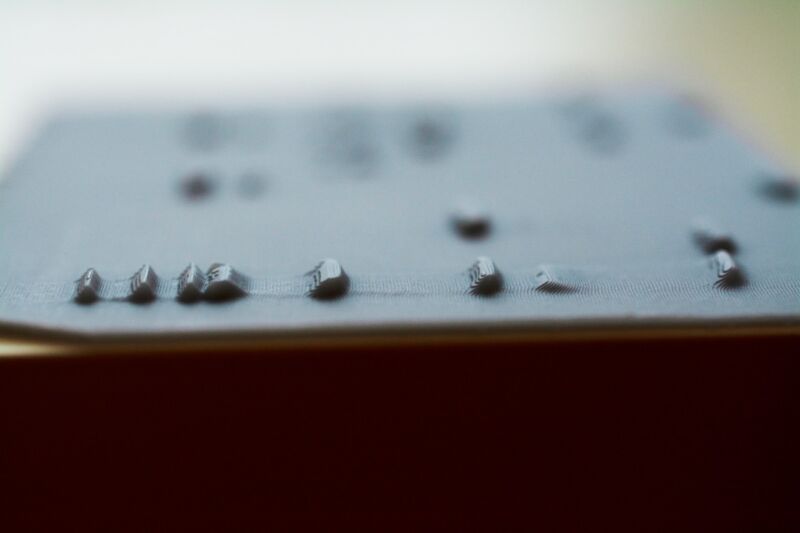

19th-century art form revived to make tactile science graphics for blind people
source link: https://arstechnica.com/science/2022/08/19th-century-art-form-revived-to-make-tactile-science-graphics-for-the-blind/
Go to the source link to view the article. You can view the picture content, updated content and better typesetting reading experience. If the link is broken, please click the button below to view the snapshot at that time.

"Data for all" —
19th-century art form revived to make tactile science graphics for blind people
"Everything I can see with my eyes, a person who is blind can feel with their fingers."
Jennifer Ouellette - 8/31/2022, 10:44 PM

In the 19th century, an art form known as lithophanes was all the rage in Western Europe. These thin engravings were usually made from translucent materials like porcelain or wax. When backlit, a glowing 3D image would appear that would change its features in response to variations in the light source. Now researchers have revived this art form to create tactile graphics to illustrate scientific data that glow with high resolution. According to a recent paper published in the journal Science Advances, these lithophanes are accessible to sighted and visually impaired people, making them a universal visualization tool for scientific data.
"This research is an example of art making science more accessible and inclusive. Art is rescuing science from itself," said co-author Bryan Shaw, a biochemist at Baylor. "The data and imagery of science—for example, the stunning images coming out from the new Webb telescope—are inaccessible to people who are blind. We show, however, that thin translucent tactile graphics, called lithophanes, can make all of this imagery accessible to everyone regardless of eyesight. As we like to say, 'data for all.'"
The word "lithophane" derives from the Greek litho (stone or rock) and phainein (to cause to appear), popularly translated as "light in stone." The art form's roots may date back to ancient China, as many as 1,000 years before the Tang Dynasty. (Historical sources describe paper-thin bowls with hidden decorations.) But to date, no actual lithophanes are known to have been in China before 1800.
AdvertisementExactly who perfected the process of making lithophanes is still debated among historians. The common 19th-century process involved etching a 3D design into a thin sheet of translucent wax or porcelain using traditional relief and intaglio printmaking techniques. More light would shine through the parts of the carving where the wax was thinnest.
-
Old Japanese cups, showing lithophanes of ladies
-
3D printed lithophanes of popular imagery created between 1926 and 1977.
These lithophanes were between one-sixteenth of an inch to a quarter-inch thick. They were displayed as plaques, hung in windows or in front of shields with lit candles behind them as a light source. Lithophanes could also serve as night lights, fireplace screens, tea warmers, or ornaments engraved with erotic images. American industrialist Samuel Colt filled his Hartford, Connecticut, home with more than 100 lithophanes and commissioned 111 lithophane versions of a photograph of himself to give to friends and associates.
The technique fell out of favor after the invention of photography, but the advent of 3D printing has revived interest. Today, lithophanes are typically made with plastic, 3D printed from any 2D image that has been converted to a 3D topograph, according to Shaw and his co-authors, which they did with free online software. Four of those co-authors have been blind since birth or childhood, yet still successfully completed their PhDs. But they are rare examples. Finding a way to create universal tactile science graphics that both blind and sighted individuals can use would remove a longstanding barrier that has kept many visually impaired people out of the sciences.
Page:
Recommend
-
 39
39
In an unimaginable turn of events, LibreDWG, the free/libre library for opening proprietary CAD files in the DWG file format, is becoming a stellar example of a FOSS project.
-
 43
43
The future is (still) now The premier UX of the 21st century just got a little better: With chafa, you can now view very, very reasonable approximations of pictures and animations in the comfort of your...
-
 17
17
April 13, 2021
-
 11
11
Low-cost soft prosthetic hand offers real-time tactile control ...
-
 9
9
News Tactile Sensing Gets a Boost for AI Systems Thanks to Open-source Research one day ago by Jake Hertz AI system sensing kee...
-
 11
11
Dot Pad tactile display makes images touchable for visually impaired usersDevin ColdeweyFri, March 11, 2022, 3:48 AM·9 min readBraille is widely used by people with vision i...
-
 5
5
Tactile利用既有的传感器提升轮胎安全监测-汽车电子-与非网
-
 10
10
Fitbit finally reveals Inspire 3, Sense 2 and Versa 4 – and the tactile button is back
-
 6
6
Transcript Listen to the latest from the world of science, with Shamini Bundell and Benjamin Thompson. Host: Benjamin Thompson
-
 3
3
README.md
About Joyk
Aggregate valuable and interesting links.
Joyk means Joy of geeK